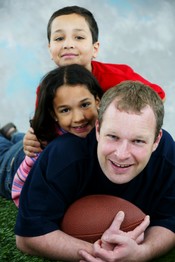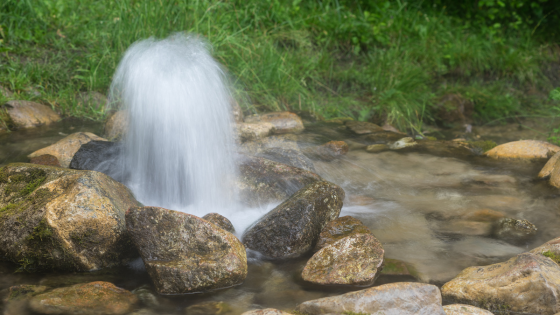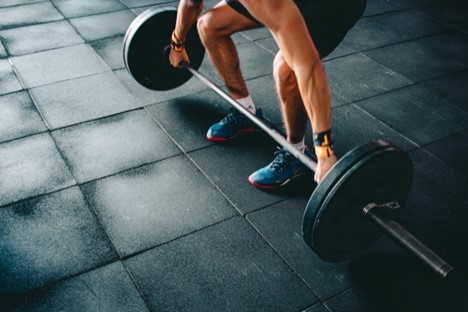 What makes today’s kids so different from a generation or two ago? Aren’t children just naturally active, like when we were kids? Well—yes and no, says Joann Donnelly, Director of Total Health for the YMCA of Greater Houston.
What makes today’s kids so different from a generation or two ago? Aren’t children just naturally active, like when we were kids? Well—yes and no, says Joann Donnelly, Director of Total Health for the YMCA of Greater Houston.
“If you take a close look at America’s cultural environment over the last 20 to 30 years, weight gain has been almost inevitable,” says Donnelly. “Technology has brought us countless ‘labor-saving’ devices, family mealtime is spent at the drive-thru, and kids (and parents) spend time on computers, not on bikes. Movement has virtually been stripped out of our lives.”
Even the educational system has fewer opportunities for physical activity. Donnelly remembers, “We used to have gym three to five times a week, and it was vigorous. Most parents don’t realize that that environment doesn’t still exist.”
A generation or two ago, kids would walk, run, or bike home from school where they were greeted with Mom’s “Now, go outside and play—I don’t want to see you until dinnertime.” But today’s roads and neighborhoods aren’t necessarily as safe as they used to be, and many kids can’t go just go outside to play with friends unsupervised. Parents have to be involved. The best way to give our sedentary culture a makeover is by starting within the family—by exercising together.
WHY ‘TOGETHER’?
Dr. Ron Eaker, M.D. OB-GYN, author of Fat-Proof Your Family, says that, “exercising with children reprograms kids to understand what is normal and what is not. Kids today believe that a sedentary lifestyle is normal. Studies show that most kids spend an average of 6 hours after school doing sedentary things like TV, computers, and video games. The have a skewed perception of ‘normal.’”
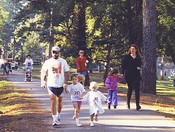 “But exercising with them ingrains a new standard of what is normal,” Dr. Eaker continues. “It establishes an environment of exercise by teaching them ‘this is what adults do.’ Exercising together gives them a sense of ownership and participation in adult activities.” Photo courtesy of Dr. Ron Eaker
“But exercising with them ingrains a new standard of what is normal,” Dr. Eaker continues. “It establishes an environment of exercise by teaching them ‘this is what adults do.’ Exercising together gives them a sense of ownership and participation in adult activities.” Photo courtesy of Dr. Ron Eaker
Changing our exercise habits has to be a family effort. Most parents don’t recognize the power they have to model healthy behavior to their children. “Specifically, the mother is the primary influencer of the family’s health—far and above any other factor,” says Dr. Eaker. “She’s often responsible for the food brought into the family and the preparation of the meals, but sociological studies also indicate that the exercise pattern is set by the mother. She becomes the role model for both male and female children.”
“Parents sign up their kids for programs,” adds Joann Donnelly, “but they don’t always make the connection that what they model, through their actions and their attitudes about exercise, impacts their children more than anything else. “Not exercising sends a message to kids that it’s not important. But when parents and kids are active together, it gives them a common sense of purpose and a goal,” continues Donnelly. “Exercise benefits both of them in mind, body, and spirit.”
“Research shows that children who exercise do better in school, control themselves better, and have fewer behavior issues,” Donnelly says. “If parents and teachers could recognize the difference it would make in their kids, they’d have kids exercising constantly!”
Perhaps most importantly, exercising together brings families together. It gives parents and children the opportunity to have meaningful conversations and to really get to know one another. Often, parents find that devoting time to exercising with their kids prompts natural discussions about personal discipline and how it relates to faith.
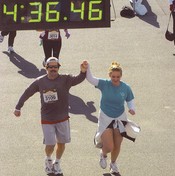 “This concept of ‘Quality Time’ is bogus,” claims Dr. Eaker. “It’s the quantity of time that matters. You can’t manufacture quality moments. Opportunities just happen spontaneously. So many times, what we’re doing prompts a conversation about God or about faith. Those opportunities don’t come up because ‘Now we’re doing Quality Time.’ But when you remove all the other distractions and busyness, you have the time to talk to one another.” Photo courtesy of Dr. Ron Eaker
“This concept of ‘Quality Time’ is bogus,” claims Dr. Eaker. “It’s the quantity of time that matters. You can’t manufacture quality moments. Opportunities just happen spontaneously. So many times, what we’re doing prompts a conversation about God or about faith. Those opportunities don’t come up because ‘Now we’re doing Quality Time.’ But when you remove all the other distractions and busyness, you have the time to talk to one another.” Photo courtesy of Dr. Ron Eaker
THREE STAGES FOR THE FAMILY EXERCISE MAKEOVER
How can you and your family get started? It’s simpler than you may think
.
EARLY STAGE: EXERCISING WITH YOUR INFANT OR TODDLER
Lifelong behavior patterns become ingrained during our earliest years. Infants and toddlers establish most of their habits by age 3. “They have this intrinsic ability to be active,” says Dr. Eaker. “That’s one of God’s greatest gifts to us. We’re born with a natural ability and interest in being physically active. But we get that trained out of us as we age.” Exercising with your infant or toddler doesn’t have to be a big thing. It can be as simple as taking a walk. “I have this picture of my daughter on my wall in my office,” says Dr. Eaker. “I was training for this 10K race and pushing her in a stroller. It seems like a silly example, but it was all part of showing her from an early age, that this is what adults do.”
MID-STAGE: EXERCISING WITH YOUR EARLY ADOLESCENT
Children between 4 and 10 are physically active, but they call it “play.” They are physically developed enough to ride a bike with their parents, go for walks, play active games like tag, or negotiate a simple obstacle course. According to Dr. Eaker, “If a child at age 10 is physically active on a consistent basis, for about an hour a day, they have a 75% less likelihood of being overweight as an adult.”
Competitions are a great way to engage early adolescents. If your family’s habit is watching television in the evenings, then start small. “Make a game of it,” suggests Dr. Eaker. “When a commercial comes on, entice them by saying, ‘We’re going to have a little competition.’” Challenge your child to see how many sit ups they can do, how long they can run in place, or who can do the most jumping jacks.
Joann Donnelly says, “It’s the simple things, like taking the dog for a walk, putting on music and dancing together for 20 to 30 minutes a day, doing chores like gardening together…. They’re ‘chores’ if you do them alone, but if you do them together, they become something more, something fun.”
Organized sports can offer great opportunities for preadolescent activity. Some communities offer parent-child teams and leagues, but more often, kids play on teams with other kids. “The parent’s role may just be making sure their child has the opportunity and being present—not necessarily being active, but being a support,” says Dr. Eaker. Be prepared to provide your child with what she needs, but always be clear that “when it stops being fun, we’ll move on to something else.”
“The key is letting your child find his own passion. Don’t be like the overzealous Little League Dad and force your child into something they don’t really want to do,” warns Dr. Eaker. “It’s easier for the parent to be the one to adapt. Don’t try to force your child into a physical activity just because it’s the one you like.”
TEEN STAGE: EXERCISING WITH YOUR OLDER CHILD
Sedentary tweens and teens are often the biggest challenge when it comes to initiating exercise. “It has to be something they have some ownership of and see results from,” says Dr. Eaker. “You can’t force them to be active for very long.”
Multitasking can be an option for older children. “I’m sure I’m going to take some flack for this,” says Dr. Eaker, “but in our family, we don’t allow the TV on during weekdays. So we’ve made a deal with my 14-year-old daughter. If there’s a half-hour show she wants to watch through the week, she can, but she watches it while she’s on a treadmill. That’s the carrot-on-a-stick that works to keep her active.
 “Her interests change every 15 to 20 minutes. She’s not keen on ‘Family Activities’ anymore, so we’ve started ‘Group Activities.’ Including her friends has made a big difference. We might say, ‘We’re going for a bike ride. Why don’t you invite one of your friends, and we’ll throw all the bikes in the back of the car?’ instead of saying, ‘Okay! Time for a family activity!”
“Her interests change every 15 to 20 minutes. She’s not keen on ‘Family Activities’ anymore, so we’ve started ‘Group Activities.’ Including her friends has made a big difference. We might say, ‘We’re going for a bike ride. Why don’t you invite one of your friends, and we’ll throw all the bikes in the back of the car?’ instead of saying, ‘Okay! Time for a family activity!”
Service projects and fundraisers that involve physical activity can be a great way to make exercise appealing to older children. “Sometimes you can tap into the burgeoning desire they have to help, to make a difference—something where they feel like they’re making an impact on their world and contributing something,” says Dr. Eaker. “I call it ‘Stealth Exercise.’ It really works with this age group of kids.”
FAMILY ACTIVITIES AT YOUR LOCAL YMCA
Nationally, as a movement, the YMCA is making a focused effort to provide opportunities for family fitness.
Through the “Activate America” initiative, “We are looking at how the YMCA can take a stronger role in family wellness,” says Donnelly. “We want to provide more opportunities for the family unit to do together. We currently offer a lot of activities for adults and for children and for teens, but they are typically segmented by age.”
Many YMCAs have implemented a monthly Family Night for the children who participate in their after-school programs. “Instead of just picking their kids up after the program, parents will stay and participate in the program. They’ll have a healthy dinner, some kind of educational activity about wellness, and a game or activity that they do together.” Parents even help plan the Family Night activities. “They really buy into and engage in the program when we partner with them.”
Individual YMCAs are also considering opportunities for daily and weekly family activities. “Some examples of what that could look like would be having parent-child sports leagues. Right now we have some parent-child classes, but we’d like to expand our offerings and have even more variety. The family-oriented classes need to be more the rule than the exception,” says Donnelly. What family programs are available at the YMCA, club or church fitness center in your neighborhood?
THINK IT’S TOO LATE FOR YOUR FAMILY?
It’s never too late to start a healthy habit! It may take a little effort to overcome a sedentary child’s initial reluctance, but just remember to start slowly. Every minute of activity helps. “It’s those first 20 to 30 minutes of moderate exercise that reap the biggest benefits,” reports Donnelly. “Studies show that people who go from doing nothing [no exercise] to doing just a little bit—just 20 to 30 minutes—gain the most health benefit.
“Really, it’s all about the commitment. People can be pretty creative once they get started. Parents just need to recognize that they don’t have to turn everybody into marathon runners. If they just make the effort to get that first 20 to 30 minutes, they’ll see huge benefits."
Dr. Ron Eaker’s book, Fat Proof Your Family, is available at www.FatProofYourFamily.com
 Jodi Knepper is a freelance writer and editor from Reading, Pennsylvania. She can be contacted by email at knepper@ptd.net.
Jodi Knepper is a freelance writer and editor from Reading, Pennsylvania. She can be contacted by email at knepper@ptd.net.

